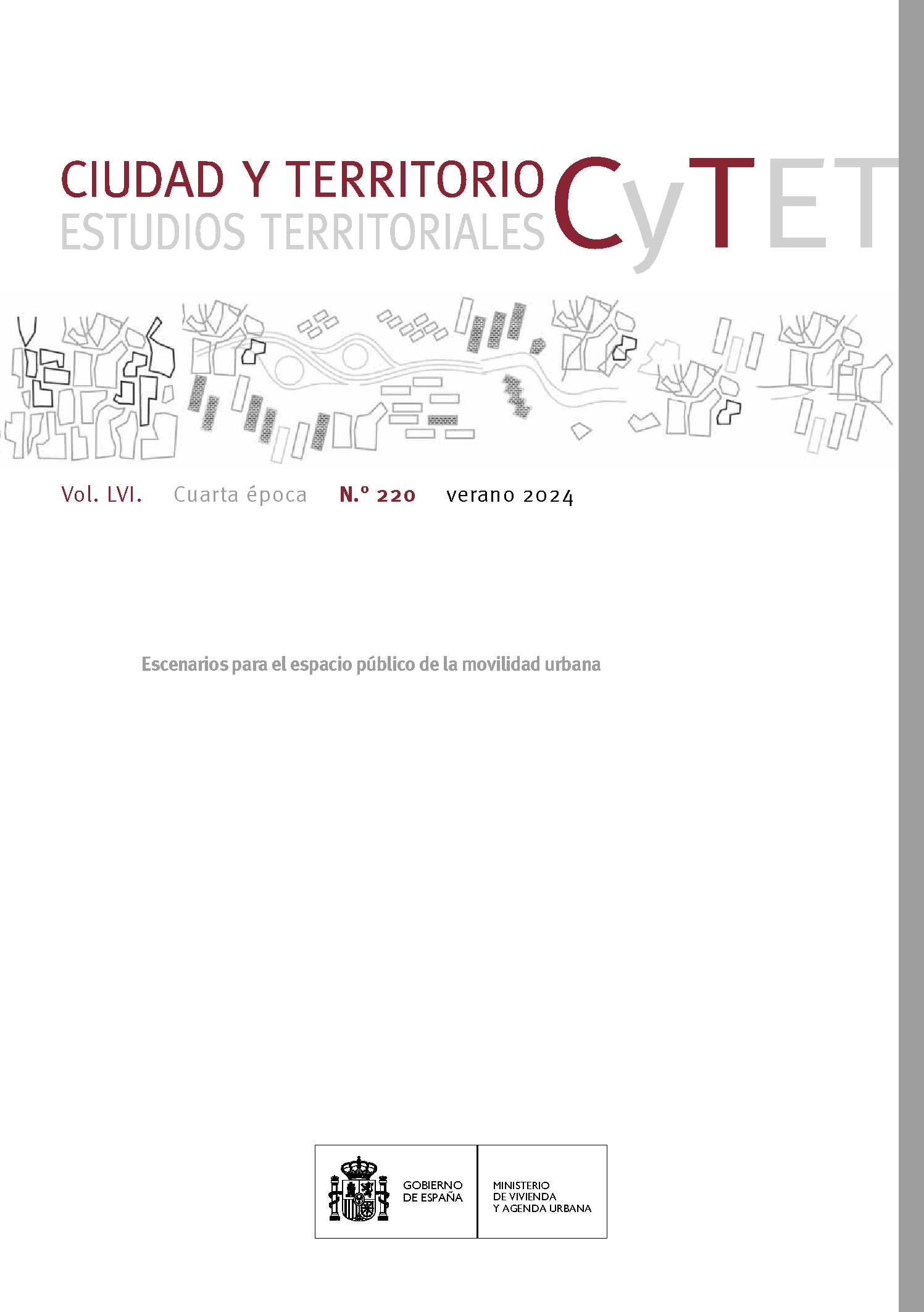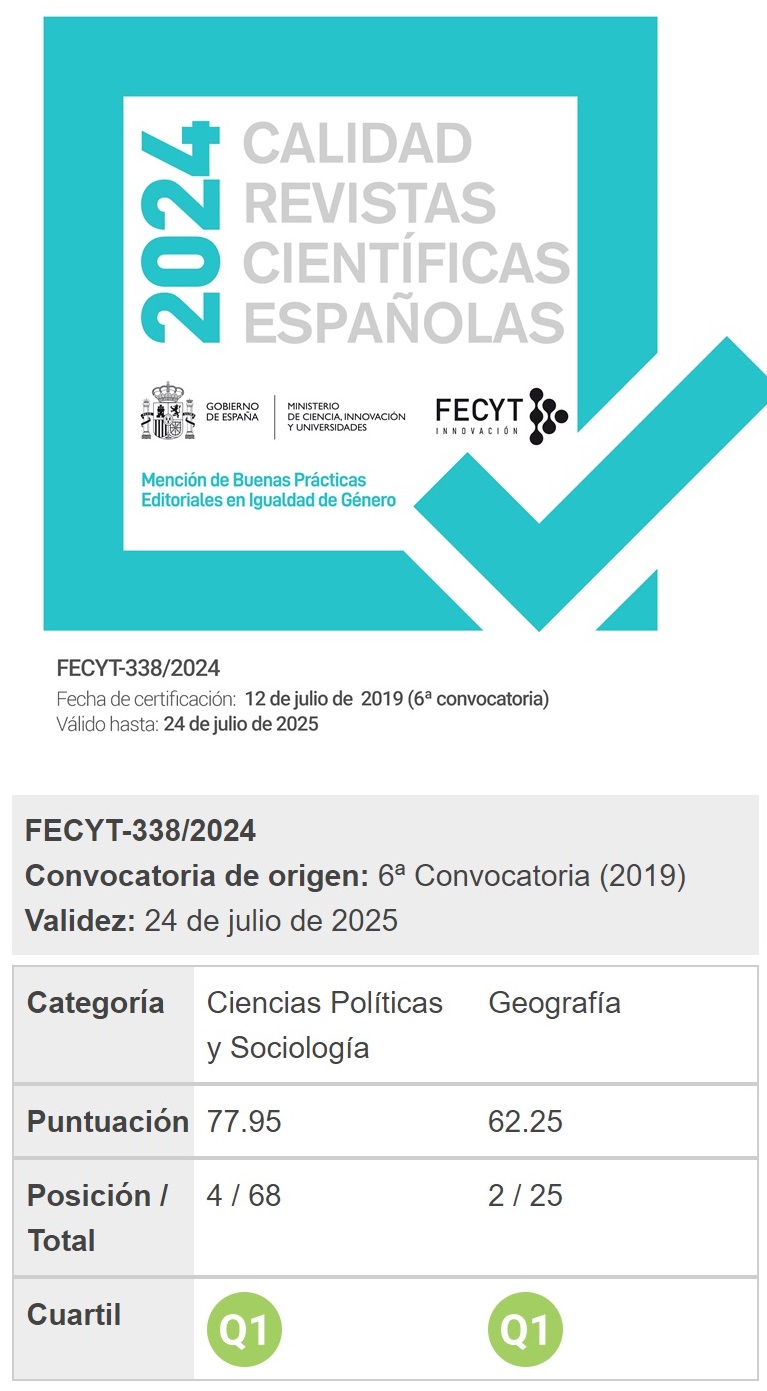La caminabilidad y la mortalidad asociada a factores de riesgo cardiovascular en la ciudad de Granada
DOI:
https://doi.org/10.37230/CyTET.2024.220.5Palabras clave:
Salud urbana, Caminabilidad, Mortalidad, Participación ciudadana, Perspectiva de géneroResumen
Los entornos urbanos influyen en la salud y son determinantes para reducir desigualdades sociales. La caminabilidad desempeña un papel crucial en la planificación urbana y la promoción de la salud. Este estudio evaluó la caminabilidad de Granada y su asociación con la mortalidad por enfermedades cardiovasculares. Utilizando un enfoque mixto con participación ciudadana y análisis ecológico en 183 secciones censales, se calcularon los índices de caminabilidad (Walk Score©) y se analizó su asociación con la mortalidad. Nuestros hallazgos revelaron una preferencia por una ciudad peatonal y movilidad sostenible. Los resultados cuantitativos mostraron diferencias espaciales significativas en la mortalidad según Walk Score©, sexo y enfermedades específicas. Este enfoque mixto enriqueció nuestra comprensión de la caminabilidad en Granada y su influencia en la salud cardiovascular.
Descargas
Citas
BOER, R. & ZHENG, Y. & OVERTON, A. & RIDGEWAY, G. K. & COHEN, D. A. (2007): Neighborhood Design and Walking Trips in Ten U.S. Metropolitan Areas. American Journal of Preventive Medicine, 32(4), 298-304. https://doi.org/10.1016/j.amepre.2006.12.012
BORRELL, C. & MARÍ-DELL’OLMO, M. & SERRAL, G. & MARTÍNEZ-BENEITO, M. & GOTSENS, M. (2010): Inequalities in mortality in small areas of eleven Spanish cities (the multicenter MEDEA project): Health & Place, 16(4), 703-711. https://doi.org/10.1016/j.healthplace.2010.03.002
COL·LECTIU PUNT 6 (2019): Urbanismo feminista: Por una transformación radical de los espacios de vida. https://www.punt6.org/es/books/urbanismo-feminista/ ISBN: 978-84-92559-99-2, 224 páginas, español.
COL LECTIU PUNT 6 (ORTIZ ESCALANTE, S. & CIOCOLETTO, A. & FONSECA, M. & CASANOVAS, R. & VALDIVIA, B.) (2021): Movilidad Cotidiana con Perspectiva de Género: Guía metodológica para la planificación y el diseño del sistema de movilidad y transporte. http://scioteca.caf.com/handle/123456789/1725
DE COURRÈGES, A. & OCCELLI, F. & MUNTANER, M. & AMOUYEL, P. & MEIRHAEGHE, A. & DAUCHET, L. (2021): The relationship between neighbourhood walkability and cardiovascular risk factors in northern France. The Science of the Total Environment, 772, 144877. https://doi.org/10.1016/j.scitotenv.2020.144877
DÍEZ, E. & AVIÑÓ, D. & PAREDES-CARBONELL, J. J. & SEGURA, J. & SUÁREZ, Ó. & GEREZ, M. D. & PÉREZ, A. & DABAN, F. & CAMPRUBÍ, L. (2016): Una buena inversión: La promoción de la salud en las ciudades y en los barrios. Gaceta Sanitaria, 30, 74-80. https://doi.org/10.1016/j.gaceta.2016.04.015
DIEZ ROUX, A. V. & GREEN FRANKLIN, T. & ALAZRAQUI, M. & SPINELLI, H. (2007): Intraurban Variations in Adult Mortality in a Large Latin American City. Journal of Urban Health, 84(3), 319-333. https://doi.org/10.1007/s11524-007-9159-5
DIEZ ROUX, A. V. & MAIR, C. (2010): Neighborhoods and health: Neighborhoods and health. Annals of the New York Academy of Sciences, 1186(1), 125-145. https://doi.org/10.1111/j.1749-6632.2009.05333.x
DOVEY, K. & PAFKA, E. (2020): What is walkability? The urban DMA. Urban Studies, 57(1), 93-108. https://doi.org/10.1177/0042098018819727
FARIÑA-TOJO, J. (2019): La Agenda Urbana Española: Hacia una ciudad más saludable. En Ciudad y Territorio. Estudios territoriales: Vol. LI (Invierno 2019, pp. 753-764). https://oa.upm.es/62651/1/AUE_ciudad_saludable.pdf
FARIÑA-TOJO, J. & HIGUERAS, E. & ROMÁN, E. (2019): Ciudad Urbanismo y Salud. Documento Técnico de criterios generales sobre parámetros de diseño urbano para alcanzar los objetivos de una ciudad saludable con especial énfasis en el envejecimiento activo. https://www.sanidad.gob.es/areas/promocionPrevencion/entornosSaludables/local/estrategia/herramientas/docs/Ciudad_urbanismo_y_salud.pdf
FARIÑA-TOJO, J. & HIGUERAS, E. & ROMÁN, E. & POZO, E. (2022): Guía para planificar ciudades saludables. Ministerio de Sanidad, FEMP. https://www.sanidad.gob.es/areas/promocionPrevencion/entornosSaludables/local/estrategia/herramientas/docs/Guia_Planificar_Ciudades_Saludables.pdf
FORSYTH, A. (2015): What is a walkable place? The walkability debate in urban design. URBAN DESIGN International, 20(4), 274-292. https://doi.org/10.1057/udi.2015.22
GALARRAGA, P. & VIVES, M. & CABRERA-MANZANO, D. & URDA, L. & BRITO, M. & GEA-CABALLERO, V. (2018): La incorporación de la salud comunitaria en la planificación y la transformación del entorno urbano. Informe SESPAS 2018. Gaceta Sanitaria, 32, 74-81. https://doi.org/10.1016/j.gaceta.2018.08.001
GARCÍA-CALVENTE, M. DEL M. & MATEO-RODRÍGUEZ, I. & EGUIGUREN, A. P. (2004): El sistema informal de cuidados en clave de desigualdad. Gaceta Sanitaria, 18(4), 132-139. https://www.scielosp.org/pdf/gs/2004.v18suppl1/132-139/es // https://dialnet.unirioja.es/servlet/articulo?codigo=860227
HAEBERER, M. & LEÓN-GÓMEZ, I. & PÉREZ-GÓMEZ, B. & TÉLLEZ-PLAZA, M. & PÉREZ-RÍOS, M. & SCHIAFFINO, A. & RODRÍGUEZ-ARTALEJO, F. & GALÁN, I. (2020): Social inequalities in tobacco-attributable mortality in Spain. The intersection between age, sex and educational level. PLoS ONE, 15(9), e0239866. https://doi.org/10.1371/journal.pone.0239866
INDIA-ALDANA, S. & RUNDLE, A. G. & ZELENIUCH-JACQUOTTE, A. & QUINN, J. W. & KIM, B. & AFANASYEVA, Y. & CLENDENEN, T. V., KOENIG, K. L. & LIU, M. & NECKERMAN, K. M. & THORPE, L. E. & CHEN, Y. (2021): Neighborhood Walkability and Mortality in a Prospective Cohort of Women. Epidemiology (Cambridge, Mass.), 32(6), 763-772. https://doi.org/10.1097/EDE.0000000000001406
JACOBS, J. (2011): Muerte y vida de las grandes ciudades (Á. Abad & A. Useros, Trads.; 1a. edición en Capitán Swing Libros). Capitán Swing Libros. https://dialnet.unirioja.es/servlet/articulo?codigo=6408259 , ISBN: 9788493898502, 488 páginas, español traducido.
JAMES, P. & HART, J. E. & LADEN, F. (2015): Neighborhood walkability and particulate air pollution in a nationwide cohort of women. Environmental Research, 142, 703-711. https://doi.org/10.1016/j.envres.2015.09.005
JONES, A. C. & CHAUDHARY, N. S. & PATKI, A. & HOWARD, V. J. & HOWARD, G. & COLABIANCHI, N. & JUDD, S. E. & IRVIN, M. R. (2021): Neighborhood Walkability as a Predictor of Incident Hypertension in a National Cohort Study. Frontiers in Public Health, 9, 611895. https://doi.org/10.3389/fpubh.2021.611895
KERN, L. & PATRI, R. (2021): Ciudad feminista: La lucha por le espacio en un mundo diseñado por hombres. Bellatera. ISBN-10 : 8418684003, ISBN-13 : 978-8418684005, 185 páginas, español.
LANG, J. J. & PINAULT, L. & COLLEY, R. C. & PRINCE, S. A. & CHRISTIDIS, T. & TJEPKEMA, M. & CROUSE, D. L. & DE GROH, M. & ROSS, N. & VILLENEUVE, P. J. (2022): Neighbourhood walkability and mortality: Findings from a 15-year follow-up of a nationally representative cohort of Canadian adults in urban areas. Environment International, 161, 107141. https://doi.org/10.1016/j.envint.2022.107141
LAVIN, T. & HIGGINS, C. & METCALFE, O. & JORDAN, A. (2006): Health Impacts of the Built Environment: A Review. Institute of Public Health in Ireland. https://publichealth.ie/sites/default/files/resources/Health_Impacts_of_the_Built_Environment_A_Review.pdf
LESLIE, E. & SAELENS, B. & FRANK, L. &, OWEN, N. & BAUMAN, A.& COFFEE, N. & HUGO, G. (2005): Residents’ perceptions of walkability attributes in objectively different neighbourhoods: A pilot study. Health & Place, 11(3), 227-236. https://doi.org/10.1016/j.healthplace.2004.05.005
LO, R. H. (2009): Walkability: What is it? Journal of Urbanism: International Research on Placemaking and Urban Sustainability, 2(2), 145-166. https://doi.org/10.1080/17549170903092867
LÓPEZ-SÁNCHEZ, M. P. & ALBERICH, T. & AVIÑÓ, D. & FRANCÉS GARCÍA, F. & RUIZ-AZAROLA, A. & VILLASANTE, T. (2018): Herramientas y métodos participativos para la acción comunitaria. Informe SESPAS 2018. Gaceta Sanitaria, 32, 32-40. https://doi.org/10.1016/j.gaceta.2018.06.008
MARMOT, M. (2005): Social determinants of health inequalities. The Lancet, 365(9464), 1099-1104. https://doi.org/10.1016/S0140-6736(05)71146-6
MIRA, J. J. & CARRILLO, I. & NAVARRO, I. & GUILABERT, M. & VITALLER, J. & PÉREZ-JOVER, V. & AGUADO, H. (2018): Public participation in health. A review of reviews. Anales del Sistema Sanitario de Navarra, 41(1), 91-106. https://doi.org/10.23938/ASSN.0172
MONGIL JUÁREZ, D. (2012): Planificación urbana, regeneración urbana integral y participación ciudadana en Cataluña: Balance y retos de futuro. En La ciudad de abajo arriba. Aportaciones para la práctica y la teoría del urbanismo participativo (pp. 73-91). https://revistascientificas.us.es/index.php/HyS/issue/view/359
ORGANIZACIÓN DE LAS NACIONES UNIDAS. (2019): Revisión de las Perspectivas de la Población Mundial de 2019. https://population.un.org/wup/Country-Profiles/
POZUETA, J. & LAMÍQUIZ DAUDÉN, F. J. & PORTO SCHETTINO, M. (2013): La ciudad paseable: Recomendaciones para la consideración de los peatones en el planeamiento, el diseño urbano y la arquitectura. Madrid Cedex 2013. https://ceh.cedex.es/tienda/?product=la-ciudad-paseable
RIVERA DE LOS SANTOS, F. & RAMOS VALVERDE, P. & MORENO RODRÍGUEZ, C. & HERNÁN GARCÍA, M. (2011): Análisis del modelo salutogénico en España: Aplicación en salud pública e implicaciones para el modelo de activos en salud. Revista Española de Salud Pública, 85(2), 129-139. https://www.redalyc.org/pdf/170/17020112002.pdf
SAELENS, B. E. & HANDY, S. L. (2008): Built Environment Correlates of Walking: A Review. Medicine & Science in Sports & Exercise, 40(7), S550-S566. https://doi.org/10.1249/MSS.0b013e31817c67a4
SÁNCHEZ DE MADARIAGA, I. (2004): Urbanismo con perspectiva de género. Instituto Andaluz de la Mujer. https://www.juntadeandalucia.es/organismos/inclusionsocialjuventudfamiliaseigualdad/servicios/publicaciones/detalle/43632.html : ISBN 84-7921-101-6, 100 páginas, español.
SÁNCHEZ-VILLEGAS, P. & CABRERA-LEÓN, A. & GIL GARCÍA, E. (2021): Asociación entre la caminabilidad del barrio de residencia y la mortalidad por distintas causas en Andalucía. Gaceta Sanitaria, 35(3), 260-263. https://doi.org/10.1016/j.gaceta.2019.06.004
UNITED NATIONS DEPARTMENT OF ECONOMIC AND SOCIAL AFFAIRS, POPULATION DIVISION. (2021): Global Population Growth and Sustainable Development.
VALLS-LLOBET, C. (2020): Mujeres invisibles para la medicina: Desvelando nuestra salud. Capitán Swing.
WALK SCORE PROFESSIONAL. (2023): Walk Score Professional - For Your Project, Site or Mobile App. Walk Score Widget and Walk Score API. https://www.walkscore.com/professional/
WILKINSON, R. G. & MARMOT, M. (1998): The solid facts: Social determinants of health (EUR/ICP/CHVD 03 09 01; p. 32). WHO Regional Office for Europe. https://apps.who.int/iris/handle/10665/108082
WORLD HEALTH ORGANIZATION. (2021): One Health High-Level Expert Panel Annual Report 2021 (p. 35). WHO. https://www.who.int/publications/m/item/one-health-high-level-expert-panel-annual-report-2021
WORLD HEALTH ORGANIZATION. (2022): World health statistics 2022: Monitoring health for the SDGs, sustainable development goals. World Health Organization. https://apps.who.int/iris/handle/10665/356584
Publicado
Cómo citar
Número
Sección
Licencia
Derechos de autor 2024 Elena María Gras-García , Ainhoa Ruiz-Azarola

Esta obra está bajo una licencia internacional Creative Commons Atribución-NoComercial-SinDerivadas 4.0.
Sin perjuicio de lo dispuesto en la legislación vigente sobre Propiedad Intelectual, y conforme a la misma, el/la los/las autor/a/es/as que publiquen en CyTET cede/n a título gratuito, de modo no exclusivo y sin límite temporal al Ministerio de Transportes, Movilidad y Agenda Urbana los derechos para difundir, reproducir, comunicar y distribuir en cualquier formato actual o futuro, en papel o electrónico, la versión original o derivada de su obra bajo licencia de Creative Commons Reconocimiento-NoComercial-SinObraDerivada 4.0 Internacional (CC BY-NC-ND 4.0), así como para incluir o ceder a terceros la inclusión de su contenido en índices, repositorios y bases de datos nacionales e internacionales, con referencia y reconocimiento en todo caso de la autoría del mismo.
Además, al realizar el envío, el/la los/las autor/a/es/as declara/n que se trata de un trabajo original en el que se reconocen las fuentes que han sido utilizadas en su estudio, comprometiéndose a respetar la evidencia científica y a no modificar los datos originales para verificar o refutar una hipótesis de partida; que el contenido esencial del mismo no ha sido publicado previamente ni se publicará en ninguna otra obra o revista mientras esté en proceso de evaluación en la revista CyTET; y que no se ha remitido simultáneamente a otra publicación.
Los autores deben firmar un Formulario de Cesión de Derechos, que les será enviado desde la Secretaría de CyTET una vez se acepte su artículo para ser publicado.
Con el objetivo de favorecer la difusión del conocimiento, CyTET se adhiere al movimiento de revistas de Open Access (OA) y entrega la totalidad de sus contenidos a diversos índices, repositorios y bases de datos nacionales e internacionales bajo este protocolo; por tanto, la remisión de un trabajo para ser publicado en la revista presupone la aceptación explícita por parte del autor/a de este método de distribución.
Se anima a las/os autoras/es a reproducir y alojar sus trabajos publicados en CyTET en repositorios institucionales, páginas web, etc. con la intención de contribuir a la mejora de la transferencia del conocimiento y de la citación de dichos trabajos.








 Enlace a CyTET en Linkedin
Enlace a CyTET en Linkedin